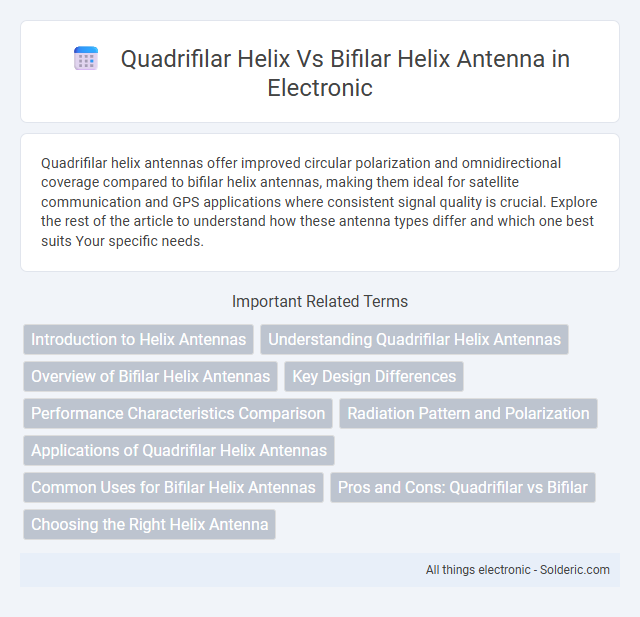Quadrifilar helix antennas offer improved circular polarization and omnidirectional coverage compared to bifilar helix antennas, making them ideal for satellite communication and GPS applications where consistent signal quality is crucial. Explore the rest of the article to understand how these antenna types differ and which one best suits Your specific needs.
Comparison Table
| Feature | Quadrifilar Helix Antenna (QHA) | Bifilar Helix Antenna (BHA) |
|---|---|---|
| Number of Elements | Four helical elements | Two helical elements |
| Polarization | Right-hand circular polarization (RHCP) | Variable; typically RHCP or linear |
| Gain | Moderate, typically 3-5 dBic | Lower, typically 2-3 dBic |
| Axial Ratio | Excellent, near 1:1 for circular polarization | Higher, less ideal for circular polarization |
| Beamwidth | Wide, roughly 90deg | Narrower than QHA |
| Applications | GPS, satellite communication, NFC | Low-profile communication, RFID, basic telemetry |
| Size & Complexity | More complex, larger size | Simpler design, smaller footprint |
| Impedance | Typically 50 Ohms | Varies, often requires matching networks |
Introduction to Helix Antennas
Helix antennas, known for their unique spiral structure, come primarily in two types: quadrifilar and bifilar. Quadrifilar helix antennas offer circular polarization and wider bandwidth, making them ideal for satellite communications and GPS applications, whereas bifilar helix antennas provide simpler construction with slightly narrower bandwidth and linear polarization. Your choice depends on the specific communication requirements related to polarization, gain, and installation complexity.
Understanding Quadrifilar Helix Antennas
Quadrifilar helix antennas consist of four intertwined helices, offering nearly omnidirectional radiation patterns and enhanced circular polarization, which improves signal reception in satellite communications and GPS applications. These antennas provide higher gain and better axial ratio performance compared to bifilar helix antennas, making them suitable for low Earth orbit satellite tracking and aviation systems. Their complex design enables improved multipath signal mitigation and more stable communication links in dynamic environments.
Overview of Bifilar Helix Antennas
Bifilar helix antennas consist of two parallel helical conductors wound in phase, offering wide bandwidth and circular polarization ideal for satellite and communication applications. Their simple design provides smooth axial radiation patterns with relatively low gain, making them suitable for compact and low-profile installations. Understanding your application requirements helps determine if the bifilar helix's balance of bandwidth and polarization meets your performance goals compared to quadrifilar alternatives.
Key Design Differences
Quadrifilar helix antennas feature four orthogonal helices, providing superior circular polarization and omnidirectional coverage compared to bifilar helix antennas, which use only two helices and offer simpler design with linear or elliptical polarization. The quadrifilar structure enhances gain consistency and multipath signal rejection, making it ideal for satellite and GPS applications. Your antenna choice impacts signal quality and coverage area, with quadrifilar designs delivering more robust performance in challenging environments.
Performance Characteristics Comparison
Quadrifilar helix antennas exhibit superior circular polarization purity and wider bandwidth compared to bifilar helix antennas, making them ideal for satellite communication and GPS applications. Bifilar helix antennas offer simpler design and lower manufacturing costs but sacrifice gain and axial ratio performance. The quadrifilar design achieves higher gain and more uniform radiation patterns, enhancing signal reliability in multipath environments.
Radiation Pattern and Polarization
Quadrifilar helix antennas produce a nearly omnidirectional radiation pattern with circular polarization, making them ideal for satellite communication and GPS applications. In contrast, bifilar helix antennas typically exhibit a more directional radiation pattern with linear or elliptical polarization, offering higher gain in specific directions. The quadrifilar design enhances polarization purity and axial ratio compared to the bifilar configuration, improving signal reliability in multipath environments.
Applications of Quadrifilar Helix Antennas
Quadrifilar helix antennas are widely used in global satellite communication systems, including GPS and Iridium networks, due to their omnidirectional radiation pattern and circular polarization, which enhance signal reliability in mobile environments. These antennas provide superior multi-path resistance and uniform coverage, making them ideal for aerospace, maritime, and wearable technology applications. Unlike bifilar helix antennas, which typically offer linear polarization and narrower bandwidth, quadrifilar designs excel in robust satellite signal reception across diverse atmospheric conditions.
Common Uses for Bifilar Helix Antennas
Bifilar helix antennas are commonly used in applications requiring circular polarization, such as satellite communication systems, GPS receivers, and space telemetry, due to their ability to maintain consistent polarization and wide bandwidth. These antennas offer simple construction and efficient radiation patterns, making them suitable for both ground and airborne platforms. Your communication system benefits from bifilar helix antennas by achieving reliable signal reception in multipath and noisy environments.
Pros and Cons: Quadrifilar vs Bifilar
Quadrifilar helix antennas offer superior circular polarization and wider bandwidth, making them ideal for satellite communication and GPS applications, while bifilar helix antennas provide simpler design and easier construction with lower cost but limited bandwidth and polarization purity. The quadrifilar design enhances signal reception in multipath environments, whereas the bifilar helix is more suitable for linear polarization needs and basic radio setups. Your choice depends on whether you prioritize advanced performance and versatility (quadrifilar) or cost-effectiveness and simplicity (bifilar).
Choosing the Right Helix Antenna
Choosing the right helix antenna depends on the application requirements such as bandwidth, gain, and polarization. Quadrifilar helix antennas provide circular polarization with wider beamwidth and better axial ratio, making them ideal for satellite communication and GPS systems. Bifilar helix antennas offer simpler design and lower cost but typically have narrower bandwidth and lower gain, suitable for basic RF communication needs.
quadrifilar helix vs bifilar helix antenna Infographic

 solderic.com
solderic.com